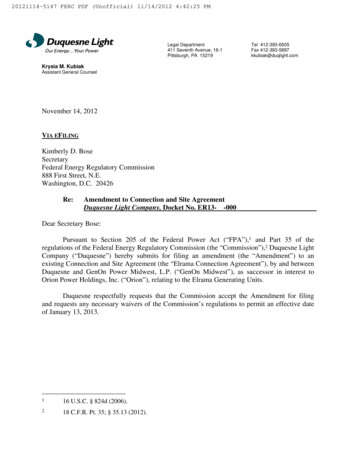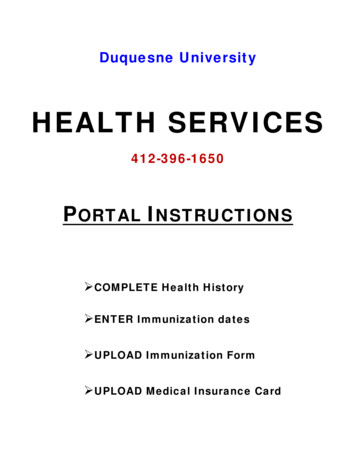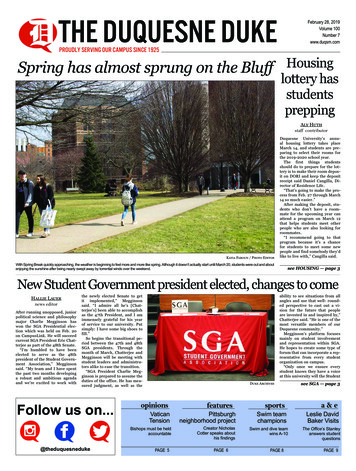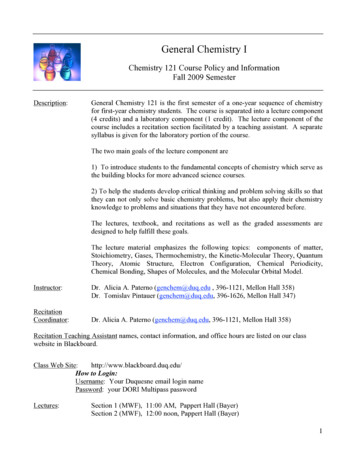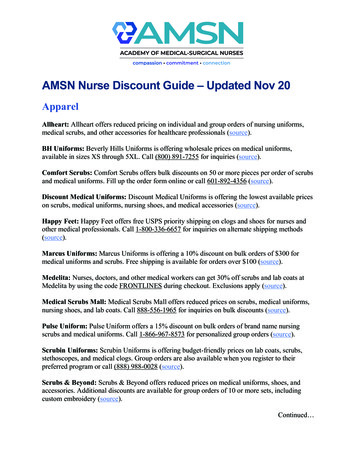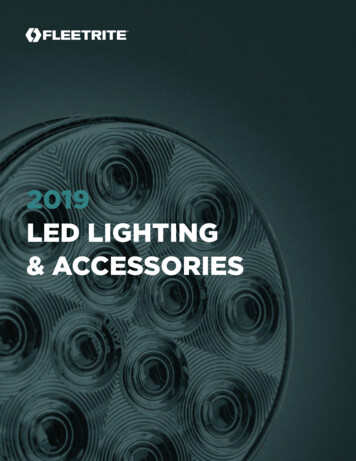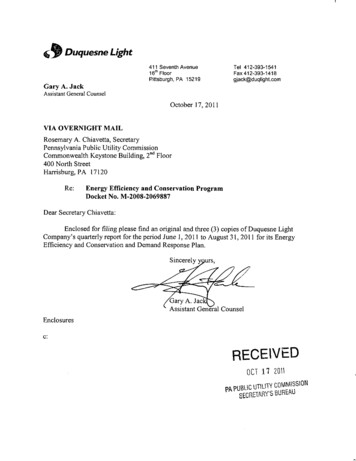
Transcription
Duquesne Light411 Seventh Avenue16' FloorPittsburgh, PA 15219Tel 412-393-1541Fax 412-393-1418gjack@duqlight.coinhGary A. JackAssistant General CounselOctober 17, 2011VIA OVERNIGHT MAILRosemary A. Chiavetta, SecretaryPennsylvania Public Utility CommissionCommonwealth Keystone Building, 2 Floor400 North StreetHarrisburg, PA 17120ndRe:Energy Efficiency and Conservation ProgramDocket No. M-2008-2069887Dear Secretary Chiavetta:Enclosed for filing please find an original and three (3) copies of Duquesne LightCompany's quarterly report for the period June 1, 2011 to August 31, 2011 for its EnergyEfficiency and Conservation and Demand Response Plan.Sincerely yours,Gary A. JaclAssistant General CounselEnclosuresc:RECEIVEDOCT n 2011PA PUBLIC UTILITY COMMISSIONSECRETARY'S BUREAU
Quarterly Report to thePennsylvania Public Utility CommissionFor the periodJune 1, 2011 to August 31, 20111 Quarter for Program Year 3stFor Act 129 of 2008Energy Efficiency and Conservation ProgramRECEIVEDOCT 17 2011Prepared by Navigant Consulting, Inc.ForDuquesne Light CompanyOctober 17, 2011PA PUBLIC UTILITY COMMISSIONSECRETARY'S BUREAU
October 17, 20111 Quarterly Report to the PA PUC, PY3 QlTable of Contents1OVERVIEW OF PORTFOLIO11.1SUMMARY OF PORTFOLIO IMPACTS1.2SUMMARY OF ENERGY IMPACTS BY PROGRAM1.3SUMMARY OF DEMAND IMPACTS BY PROGRAM1-4SUMMARY OF EVALUATION141.5SUMMARY OF FINANCES202PORTFOLIO RESULTS BY SECTOR5610222.1RESIDENTIAL EE SECTOR252.2RESIDENTIAL LOW-INCOME EE SECTOR282.3SMALL COMMERCIAL & INDUSTRIAL EE SECTOR302.4LARGE COMMERCIAL & INDUSTRIAL EE SECTOR332.5GOVERNMENT & NON-PROFIT EE SECTOR373DEMAND RESPONSE384PORTFOLIO RESULTS BY PROGRAM394.1RESIDENTIAL: ENERGY EFFICIENCY REBATE PROGRAM4.2RESIDENTIAL: SCHOOL ENERGY PLEDGE PROGRAM4.3RESIDENTIAL: APPLIANCE RECYCLING PROGRAM3943454.4RESIDENTIAL: LOW INCOME ENERGY EFFICIENCT PROGRAM494.5COMMERCIAL SECTOR PROGRAMS514.6INDUSTRIAL SECTOR PROGRAMS58DLC Pagei
October 17, 20111 Quarterly Report to the PA PUC, PY3 Q lAbbreviationsCARClerical Adjustment RateCFLCPITDCompact Fluorescent LampCumulative Program/Portfolio Inception to DateCSPDLCEDCEE&CConservation Service ProviderDuquesne Light CompanyElectric Distribution CompanyEM&VEnergy Efficiency & ConservationEvaluation Measurement and VerificationIQIRIncremental QuarterkWKilowattKilowatt-hourResidential Low-Income Energy Efficiency RRRARPSEPSWETRCTRMUESVRInstallation RateMeasurement and ylvaniaProgram Management and Reporting SystemProgram-Qualifier RatePublic Utility CommissionProgram/Portfolio YearProgram Year 3 (July 2011 to June 2012)Program/Portfolio Year to DateResidential Energy Efficiency Rebate ProgramRealization RateResidential Appliance Recycling ProgramResidential School Energy PledgeStatewide EvaluatorTotal Resource CostTechnical Reference ManualUnit Energy SavingsVerification RateDLC Page ii
October XI, 2011 Quarterly Report to the PA PUC, PY3 Ql1 Overview of PortfoliothAct 129, signed October 1 5 , 2008, mandated energy savings and demand reduction goals for thelargest electric distribution companies (EDC) in Pennsylvania. Pursuant to their goals, energy efficiencyand conservation (EE&C) plans were submitted by each EDC and approved by the Pennsylvania PublicUtility Commission (PUC). This quarterly report documents the progress and effectiveness of the EE&Caccomplishments for Duquesne Light through the end of Quarter 1 of Program Year 3.Compliance goal progress as of the end of the reporting period:Cumulative Portfolio Energy Impacts1 The CPITD reported gross energy savings are 186,836 M W h . The CPITD verified energy savings are 31,576 M W h . The CPITD unverified energy savings are 155,260 M W h . The CPITD committed energy savings are 193,946 M W h . The CPITD committed and achieved energy savings represent 45.9% of the 422,565 M W h234st5May 31 , 2013 energy savings compliance target . The preliminary realization rate for energy savings (cumulative program inception throughthe end of PY2Q2) is estimated to be 97.4%.Cumulative Portfolio Demand Reductions The CPITD reported gross demand reductions are 19.79 M W . The CPITD verified demand reductions are 2.62 M W . The CPITD unverified demand reductions are 17.17 M W . The CPITD committed demand reductions are 20.82 M W . The CPITD committed and achieved demand reductions represent 18.4% of the 113 M W6739May 3 1 " 2013 demand reductions compliance target . The preliminary realization rate for demand reductions (cumulative program inceptionthrough the end of PY2Q2) is estimated to be 93.7%.1CPITD energy savings does not yet reflect corrections being made to Program Year 2 values (e.g., with respect toRefrigerator Recycling Program savings)CPITD energy savings are verified through PY2 Q2.CPITD unverified energy savings are net of verified savings.CPITD committed energy savings include PY3 Q l projects in progress (7,110 MWh).Energy savings compliance target as communicated in EM&V plan, section 1.1.2, page 3.CPITD demand reductions are verified through PY2 Q2.CPITD unverified demand reductions are net of verified savings.CPITD committed demand reductions include PY3 Q l projects in progress (1.03 MW).Demand reductions compliance targets as communicated in EM&V plan, section 1.1.2, page 3.23456789DLC Page 1
October 17, 2011 Quarterly Report to the PA PUC, PY3 QlLow Income Sector The CPITD reported gross energy savings for low-income are 16,630 M W h (including boththe low-income portion of the upstream lighting and the low-income programs). The CPITD reported gross energy savings from low-income upstream lighting are 14,573M W h , the remaining low-income programs savings are 2,057 M W h . The CPITD verified energy savings for low-income sector programs are 786 M W h .1 0Inaddition, the low income portion of the upstream lighting program, which is not subject tofurther verification requirements, resulted in energy savings of 14,573 M W h .1 1 The CPITD unverified energy savings for low income sector programs are 1,271 M W h . The preliminary realization rate for energy savings (cumulative program inception throughthe end of PY2Q2) for low income sector programs is estimated to be 99.6%.Government and Non-Profit Sector The CPITD reported gross energy savings for government and non-profit sector programsare 27,842 M W h . The CPITD verified energy savings for government and non-profit sector programs are 5651 2MWh . The CPITD unverified energy savings for government and non-profit sector programs are1 327,277 M W h . The CPITD committed energy savings for government and non-profit sector programs are1 427,843 M W h . The CPITD committed and achieved energy savings for government and non-profit sectorprograms represent 65,9% of the 42,257 M W h M a y 3 1sl(2013 energy savings compliancetarget. The preliminary realization rate for energy savings (cumulative program inception throughthe end of PY2Q2) for government and non-profit sector programs is estimated to be 91.9%.Program Year portfolio highlights as of the end of the reporting period: The PYTD reported gross energy savings are 12,730 M W h . The PYTD verified energy savings are 0 M W h . The PYTD unverified energy savings are 12,730 M W h . The PYTD committed energy savings are 19,840 M W h . The preliminary realization rate for energy savings (total program year through the end of1 51 61 7PY2Q2) is estimated to be 97.4%. 1011121314151617The PYTD reported gross demand reductions are 0.80 M W .CPITD energy savings are verified through PY2 Q2.CPITD unverified energy savings are net of verified savings, not including upstream lighting.CPITD energy savings are verified through PY2 Q2.CPITD unverified energy savings are net of verified savings.CPITD committed energy savings include PY3 Q l projects in progress (1 MWh).PYTD energy savings have not been verified as of PY3 Q l .PYTD unverified energy savings are PY3 Q l reported gross values.PYTD committed energy savings include PY3 Q l projects in progress (7,110 MWh).DLC Page 2
October 17, 2011 Quarterly Report to the PA PUC, PY3 Ql18 The PYTD verified demand reductions are 0 M W . The PYTD unverified demand reductions are 0.80 M W . The PYTD committed demand reductions are 1.83 MW . The PYTD reported participation is 7,924 participants . The preliminary realization rate for demand reductions (total program year through the end192021of PY2Q2) is estimated to be 93.5%.Duquesne Light filed its EE&C Plan on July 1, 2009 and received Commission conditional approval onOctober 22, 2009. Many programs were launched on or about December 1, 2009. Duquesne Light'sEE&C program accomplishments have been increasing while the ramp-up activities of those programshave been subsiding.Business process teams have continued to review their processes and make mid course changes whileworking within the context of the PA PUC approved Plan.Meetings are held at a minimum monthly with the contracted CSPs for the Large Office and PrimaryMetals segments, the Small Office and Retail segments and the Mixed Industrial and Chemical segments.Events have been attended to continue the recognition of Watt Choices.For savings impact evaluation purposes, on October 9, 2011 an evaluation dataset was downloadeddirectly from PMRS that contained records of all customer actions taken to implement energy efficiencymeasures termed "projects" completed by Duquesne Light's EE&C Programs during Quarter 1 of PY 3.The program activity for PY3 Q l is summarized in Table 1-1.18192021PYTD demand reductions have not been verified as of PY3 Ql.PYTD unverified demand reductions are PY3 Q l reported gross values.PYTD committed demand reductions include PY3 Q l projects in progress {1.03 MW).Upstream CFL program participants are reported separately and not included in these program participantnumbers.DLC Page3
October 17, 20111 Quarterly Report to the PA PUC, PY3 QlTable 1-1: PY3 Ql Program Activity (Gross Reported)Reported Total Reported TotalProgram.ParticipantsEnergy ntial: Appliance Recycling540790,47698R e s i d e n t i a l : Low Income EE546231,04516C o m m e r c i a l S e c t o r U m b r e l l a EE1332,2046H e a l t h c a r e EE1199,30827Industrial S e c t o r U m b r e l l a EE0.C h e m i c a l P r o d u c t s EE000M i x e d Industrial EE186,64313Office B u i l d i n g - L a r g e - E E12,5140O f f i c e B u i l d i n g - S m a l l EE229,94610P r i m a r y M e t a l s EE000Public Agency / Non-Profit6152,00646Retail S t o r e s - S m a l l EE6147,09422R e s i d e n t i a l : EE P r o g r a m (REEP): R e b a t e P r o g r a mR e s i d e n t i a l : S c h o o l Energy P l e d g eRetail S t o r e s - L a r g e 98,405,73038500012,730,170797(CFLs)R e s i d e n t i a l : EE P r o g r a m ( U p s t r e a m Lighting)R e s i d e n t i a l : Low Income EE ( U p s t r e a m Lighting)P Y 3 - Q 1 P r o g r a m A c t i v i t y (Gross R e p o r t e d )Results of PY3 Q l EM&V will be reported in subsequent quarterly reports.DLC Page 4
October 17, 2011 Quarterly Report to the PA PUC, PY3 Ql1.1Summary of Portfolio ImpactsA summary of the portfolio reported impacts is presented in Table 1-2.Table 1-2: EDC Reported Portfolio Impacts through the End of the Reporting PeriodTotal EnergyImpact TypeSavings(MWh)Total DemandReduction (MW)0.797Reported Gross Impact: Incremental QuarterlyReported Gross Impact: Program Yearto Date12,73012,730Reported Gross Impact: Cumulative Portfolio Inception to DateUnverified Ex Post 62.622Estimated Impact: PYTD Total CommittedPreliminary PYTD Verified ImpactPreliminary PYTD Net Impact31Verified Savings: Cumulative Portfolio Inception to Date20.797NOTES:12Verification has not begun fcr.PY3QiV a l u e s provided are as of PY2 Q2.Table 1-3 below is a placeholder for summarizing the total resource summary benefits and costs.Table 1-3: Verified Preliminary Portfolio Total Evaluation Adjusted Impacts through the End of theReporting PeriodTRC CategoryTRC Benefits ( )TRC Costs ( )TRC Benefit-Cost RatioIQN/AN/APYTDN/AN/ACPITDN/AN/AN/ANOTES:Per direction from the SWE on 9/13/2010, no TRC values are provided for this report.DLC Page 5
October 17, 20111 Quarterly Report to the PA PUC, PY3 Ql1.2Summary of Energy Impacts by ProgramA summary of the reported energy savings by program is presented in Figure 1-1.Figure 1-1: CPITD Reported Gross Energy Savings by Program through the End of the Reporting PeriodCPITD Gross Energy Savings by Program50,00040,00035,000x5 25,000DLC Page 6
October 17, 20111 Quarterly Report to the PA PUC, PY3 QlA summary of energy impacts by program through the current quarter of Program Year 3 is presented inTable 1-4 and Table 1-5.Table 1-4: EDC Reported Participation and Gross Energy Savings by Program through the End of theReporting Period22Reported Gross TDResidential: EE Program (REEP): Rebate ntial: EE Program (Upstream 07903,698Residential: Appliance RecyclingResidential: Low Income EEResidential: Low Income EE (Upstream mmercial Sector Umbrella EEHealthcare EE131318632322,110110199Industrial Sector Umbrella EE004199001,229603Chemical Products EEM i x e d Industrial EE01839008714,9986,986Office Building - Large - EE120113Residential: School Energy PledgeOffice B u i l d i n g - S m a l l EEPrimary Metals EEPublic A g e n c y / Non-ProfitRetail S t o r e s - S m a l l EERetail S t o r e s - L a r g e EETOTAL 14262612,73012,7302,853186,836The CPITD savings values were updated to include four Program Year 2 projects that had previously not beencounted in the Program Year 2 preliminary report, as well as a savings correction made to an existing projectincluded in that report. However, the CPITD values shown do not include final adjustments yet to be made toProgram Year 2 savings (e.g., for the Refrigerator Recycling program).DLC Page 7
October 17, 2011 [ Quarterly Report to the PA PUC, PY3 QlTable 1-5: EDC Reported Gross Energy Savings by Program through the End of the Reporting PeriodUnverifiedEx PostProgramSavings(MWh)Residential: EE Program (includes upstream lighting)Projects inProgress(MWh)1Residential; School Energy PledgeResidential: Appliance RecyclingResidential: Low Income EE (includes upstream lighting)Commercial Sector Umbrella EE1161Healthcare EEIndustrial Sector Umbrella EE264Chemical Products EEMixed Industrial EE3,056Office B u i l d i n g - Large - EEOffice Building-Small EEPrimary Metals EEPublic Agency / Non-ProfitRetail Stores - S m a l l EERetail Stores - Large EETOTAL PORTFOLIO0PYTDEE&C PlanTotalEstimate forPercent ofEstimateCommittedProgram 765162,20848%11%7,11012%NOTES:'Upstream lighting is separated into the REEP and low-income segments.DLC Page 8
October 17, 2011 Quarterly Report to the PA PUC, PY3 QlA summary of evaluation verified energy impacts by program is presented in Table 1-6.Table 1-6: Verified Energy Savings by Program through the End of the Reporting PeriodProgramResidential: EE Program (REEP): Rebate ProgramResidential: EE Program (Upstream Lighting)Residential: School Energy PledgeResidential: Appliance RecyclingResidential: Low Income EEResidential: Low Income EE (Upstream Lighting)Commercial Sector Umbrella EEHealthcare EEIndustrial Sector Umbrella EEChemical Products EEPYTD ReportedPreliminaryPreliminaryNet-to-Gross ImpactRealizationPYTD VerifiedGross(MWh)RateImpact ( M W h )2,627--8,406079023103219900M i x e d Industrial EE87Office B u i l d i n g - L a r g e - EE330Office B u i l d i n g - S m a l l EEPrimary Metals EEPublic Agency / Non-ProfitRetail S t o r e s - S m a l l EERetail S t o r e s - L a r g e EETOTAL PORTFOLIONOTES:1Verification has not begun f o r PY3Q101521472612,7301- N/AN/AN/AN/APYTD NetImpact(MWh)1- -N/ADLC Page 9
October 17, 2011 Quarterly Report to the PA PUC, PY3 Ql1.3Summary of Demand Impacts by ProgramA summary of the reported demand reduction by program is presented in Figure 1-2.Figure 1-2: Reported Demand Reduction by Program through the End of the Reporting PeriodCPITD Gross Demand Reduction by 5%1.003%0.50 - -4%-5%"2%—m—il—H—1%i%J0.00 -i%J?DLC Page 10
October 17, 20111 Quarterly Report to the PA PUC, PY3 QlA summary of demand reduction impacts by program through the current quarter of Program Year 3 ispresented in Table 1-7 and Table 1-8.Table 1-7: Participation and Reported Gross Demand Reduction by Program through the End of theReporting Period23Reported Gross Impact(MW)ParticipantsProgramResidential: EE Program (REEP): Rebate ProgramResidential: EE Program (Upstream 64,394CPITDResidential: School Energy PledgeResidential: Appliance RecyclingN/A0540Residential: Low Income EEResidential: Low Income EE (Upstream Lighting)546N/A0540546N/ACommercial Sector Umbrella EE1313860.0060.0060.514Healthcare EEIndustrial Sector Umbrella EEChemical Products .455M i x e d Industrial EEOffice Building - Large - EE011166Office B u i l d i n g - S m a l l EEPrimary Metals EE20200.0100.000Public Agency / Non-ProfitRetail S t o r e s - S m a l l 93Retail S t o r e s - L a r g e EETOTAL PORTFOLIO23The CPITD savings values were updated to include four Program Year 2 projects that had previously not beencounted in the Program Year 2 preliminary report, as well as a savings correction made to an existing projectincluded in that report. However, the CPITD values shown do not include final adjustments yet to be made toProgram Year 2 savings (e.g., for the Refrigerator Recycling program).DLC Page 11
October 17, 2011 Quarterly Report to the PA PUC, PY3 QlTable 1-8: Reported Gross Demand Reduction by Program through the End of the Reporting PeriodProgramUnverifiedProjects inPYTD TotalEx PostprogressCommittedSavings (MW)(MWh)(MW)EE&C PlanPercent o fEstimate forEstimateProgram 0.83112%0.0163.5010%0.0341.1503%Healthcare EE0.0272.4451%Industrial Sector Umbrella EEChemical Products EE0.O3O0.0000.0300.3890.9620%3%Mixed Industrial EE0.3660.3790.85844%0.0004.4000%Residential: EE Program (includes upstream.lighting)1Residential: School Energy PledgeResidential: Appliance RecyclingResidential: Low Income EE (includes upstream lighting)10.029Commercial Sector Umbrella EEOffice B u i l d i n g - L a r g e - E EOffice Building-Small EE0.0560.0661.9403%Primary Metals EE0.1030.1032.6474%Public Agency / 0.1941.88110%1.0281.82546.2424%Retail Stores-Small EERetail Stores-Large EETOTAL PORTFOLIO0.000NOTES:1Upstream lighting is separated intothe REEP and low-income segments.DLC Page 12
October 17, 2011 Quarterly Report to the PA PUC, PY3 QlA summary of evaluation adjusted demand impacts by program is presented in Table 1-9.Table 1-9: Verified Demand Reduction by Program through the End of the Reporting ionPYTD V e r i f i e d(MW)RateImpact ( M W )R e s i d e n t i a l : EE Program.(REEP): Rebate Program0.171R e s i d e n t i a l : EE Program (Upstream Lighting)0.385R e s i d e n t i a l : S c h o o l Energy P l e d g e0.000R e s i d e n t i a l : A p p l i a n c e Recycling0.098R e s i d e n t i a l : Low Income EE0.026R e s i d e n t i a l : Low Income EE (Upstream Lighting)0.000C o m m e r c i a l Sector U m b r e l l a EE0.006Healthcare EE0.027Industrial Sector U m b r e l l a EEC h e m i c a l Products EE0.000M i x e d Industrial EE0.013O f f i c e B u i l d i n g - Large - EE0.000Office B u i l d i n g - S m a l l EEPrimary M e t a l s EE0.010-PublicAgency/Non-Profit0.046Retail S t o r e s - S m a l l . E E0.022Retail S t o r e s - L a r g e EETOTAL PORTFOLIO0.0030.797 -PVTDProgramGross0.0000.000 Net-to Gross1RatioPYTD N e N/AN/AN/AN/AN/A10.000DLC f Page 13
October 17, 20111 Quarterly Report to the PA PUC, PY3 Ql1.4Summary of EvaluationRealization rates are calculated to adjust reported savings based on statistically significant verifiedsavings measured by independent evaluators. The realization rate is defined as the percentage ofreported savings that is achieved, as determined through the independent evaluation review. Arealization rate of 1 or 100% indicates no difference between the reported and achieved savings.Realization rates are determined by certain attributes relative to one of three protocol types. Fullydeemed TRM measure realization rates are driven by differences in the number of installed measures.Partially deemed TRM measure realization rates are driven by (1) differences in the number ofinstalled measures and (2) differences in the variables. Custom measure realization rates are driven bydifferences in the energy savings as estimated at time of installation and savings as determined by themeasurement and verification process.24Quarterly reports may not include realization rates reflecting full program-to-date activities due toongoing M&V activity. The realization rates for the full program year will be reported in the ProgramYear 3 final report.1.4.1 Impact Evaluation1.4.1.1 Evaluation Groups25Per the utility's EM&V Plan , for the purpose of conducting cost-effective EM&V, certain industrial andcommercial programs are grouped based on shared characteristics. Commercial sector retail, healthcare, large and small office and public agency partnership programs are similar enough in structure to betreated as one evaluation group . All industrial programs function in a similar enough manner that theyare treated as one evaluation group. Because of their unique program features, each residentialprogram is evaluated independently. This program level EM&V organization results in seven distinctEvaluation Groups , as shown in Table 1-10 below. Note that program theory and logic models havebeen developed for all of the program groups except for the Upstream Lighting Program.2627282A25262728TRM measures with stipulated values and variables.Evaluation Measurement and Verification Plan, 2010-2012 Energy Efficiency & Conservation Programs, July 15,2010 {EM&V Plan), sections 1.2.6 Program Level EM&V Organization, page 12.Note that in cases where the programs must be consolidated for practical M&V purposes, the sample data canbe used to provide an unbiased estimate of the average savings per project for the program group. Whileaverage savings per project can be broken out for each program in the group, the precision will be lower due tothe smaller sample sizes.EM&V Plan Table 1-7: Evaluation Groups, page 13.A common model has been developed for the commercial and industrial program groups.DLC Page 14
October 17, 2011 Quarterly Report to the PA PUC, PY3 QlTable 1-10: Evaluation GroupsEvaluation GroupsIncluded Sub ProgramsResidential: Appliance Recycling Program (RARP)Single program groupResidential: Low Income Energy EfficiencyProgram (LIEEPP)Residential :Energy Efficiency Rebate Program(REEP)Residential: School Energy Pledge Program (SEP)Single program groupSingle program groupUpstream Lighting ProgramSingle program groupCommercialIndustrialSingle program groupUmbrella, Small Office, Large Office, HealthCare and Retail, Public AgencyPartnerships/EducationUmbrella, Primary Metals, ChemicalProducts and Mixed IndustrialsIn this section, for the residential, commercial and industrial programs, we describe the sample designsand methods used to produce ex post estimates of energy and demand impacts.ResidentialBelow, we describe the approach used to produce ex post estimates of gross savings for the fourresidential programs.Estimation ApproachFor deemed measures, the total ex ante gross kWh (or kW) impact for a given PMRS record is defined asthe claimed units installed multiplied by the unit energy savings (UES). With the Verification approachfor deemed measures, there are two sub-levels of rigor, basic and enhanced. The level of rigor dependson the size of the savings. The basic level of rigor will be used for measures for which the rebate is lessthan 2,000. The enhanced level of rigor is reserved for measures for which the rebate is equal to orgreater than 2,000. Basic level of rigor involves verification by telephone survey, and enhanced level ofrigor involves on-site verification.The basic level of verification rigor methods for TRM deemed measures involves two basic steps:1. Survey a random sample of participants to verify installations and estimate verification rates.2. The claimed ex ante gross kWh and kW impacts for each PMRS record in the population fromwhich the sample was drawn are then multiplied by this verification rate.The verification used for TRM deemed measures consists of a six-step process:Step 1. The verification checklist for deemed savings measures includes data downloaded from PMRSand/or taken from hardcopy documentation for each participant installation or can be obtained bytelephone or on-site visit. The verification checklist for deemed savings measures includes:1. Participant has valid utility account number2.Measure(s) is on approved list and all parameters necessary for calculating savings are present.DLC Page 15
October 17, 2011 Quarterly Report to the PA PUC, PY3 Ql3.Proof of purchase identifies qualifying measure and is dated within the period being verified.4.Rebate payment date is in the current program period being verified.5.Unit kWh and kW are correct for each listed measure.6.Measure was actually installed at the customer site (telephone survey for basic level of rigor).Step 2. A simple random sample of participants is selected from the PMRS database.Step 3. Relevant documentation for items #1 through #5 from PMRS or other hardcopy documentationis then obtained for each sampled PMRS record.Step 4. Next, with respect to the sixth criterion: (a) for basic verification, telephone interviews areconducted with each sampled customer to confirm that they participated in the program, received therebate, and purchased and installed the efficient measure(s); and (b) for the enhanced rigor sample, onsite inspections and interviews are completed with each sampled customer to confirm that theyparticipated in the program, received the rebate, and purchased and installed the efficient measure(s).Step 5. Using the data collected from program files and surveys, a verification rate (VR) is calculated. TheVR is a function of three separate parameters:1. sample-based program-qualifier rate (PQ),2.a clerical adjustment rate (CAR), and3.an installation rate (IR).The PQ is a function of whether the first four criteria were all met. If a sampled participant record didnot meet all four criteria, the PQ would be set to zero. If a sampled participant record met all fourcriteria, the PQ would be set to one.Per the fifth criterion, for each sampled case, the unit kWh and kW for each PMRS measure arereviewed to make sure that they are consistent with agreed-upon deemed values. A CAR, which issimply the ratio of verified deemed values to PMRS deemed values, is then calculated. Note in theoriginal EM&V plan, the CAR was referred to as the realization rate (RR). MCR Performance Solutionschoose to use CAR rather than RR since the level of EM&V rigor associated with the CAR is far less thanthat typically associated with a realization rate.Per the sixth criterion, telephone interviews are conducted to verify that the measure was in factinstalled. The results of the telephone interviews are used to calculate the installation rate (IR), which isthe ratio of the telephone-verified installations to the PMRS installations.For each sampled record, the verification rate (VR) is then calculated as: PQ x CAR x IR. The VR is theratio of ex post verified savings to the ex ante savings. Expectations regarding this ratio form the basis ofthe sample design.Finally, across all sampled records, two weighted average VRs are calculated. One average VR isweighted by total gross ex ante kWh impacts for each record. The second VR is weighted by the totalgross ex ante kW impacts for each record. For a given sampled PMRS record, the total ex ante gross kWhand kW impacts are simply the unit energy savings (UES) multiplied by the units installed.DLC Page 16
October 17, 2011 Quarterly Report to the PA PUC, PY3 QlStep 6. The final step involves multiplying the total gross ex ante kWh and kW impacts for each record inthe PMRS population from which the sample was drawn by the kWh-weighted average VR and the kWweighted average VR, respectively.1.4.1.2Sample Design: LIEEP, REEP, RARP and SEPAll residential programs use the simple ratio estimator. The reasons for moving to a simple ratioestimator were that the vast majority of the measures installed in these four residential programs areexpected to be TRM deemed. This means that the savings are subjected to the basic level of rigor thatinvolved only the verification of installations. The only changes to the estimated gross savings in PMRSwould
Duquesne Light Gary A. Jack Assistant General Counsel 411 Seventh Avenue 16'h Floor Pittsburgh, PA 15219 October 17, 2011 Tel 412-393-1541 Fax 412-393-1418 gjack@duqlight.coin VIA OVERNIGHT MAIL Rosemary A. Chiavetta, Secretary Pennsylvania Public Utility Commission Commonwealth Keystone Building, 2nd Floor 400 North Street Harrisburg, PA
